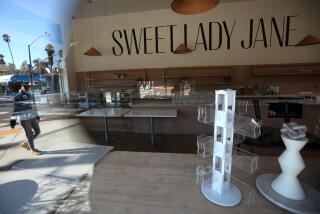Candy stores are competing for the grown-up sweet tooth

First came fancy cupcakes, then macarons, the Frenchified sandwich cookies. Improbably, gourmet doughnuts hit the scene.
Now the upscaling of once-simple pleasures has spread to a new frontier: candy. Upstart companies are launching sweet shops for grown-ups with a taste for luxury and bank accounts to match.
Some chains offer the kind of refined packaging and elegant decor more befitting Tiffany’s than a taffy joint. Instead of bins of M&Ms or Jolly Ranchers, they offer pretty boxes of Guinness-infused marshmallows, chili-laced truffles or champagne-flavored gummy bears. One confectioner has specialized in adults-only treats with bawdy names.
Such changes could drive expansion in the candy industry, which has recently enjoyed steady growth. Last year, an estimated $33.6 billion was spent on candy in the U.S., up 9.8% from 2010, according to the National Confectioners Assn.
Candy firms have traditionally targeted children ages 14 and younger. But growing awareness of childhood obesity — combined with a rising number of households without young ones — has sweets peddlers rushing to win over adults with extra pocket change.
“Adults were basically untapped until a few years ago,” said Amal Ahmad, an industry analyst with IBISWorld. “There is a lot of room for innovation.”
Dylan’s Candy Bar, co-founded in 2001 by retail mogul Ralph Lauren’s daughter Dylan, was among the first to create a sweets empire geared for hip grown-ups. Over the years, Dylan’s has turned into a brand that also sells jewelry, clothing and gadgets.
But these new entries are aiming for a different crowd with more mature tastes in sugar and fat.
The candy industry has grown stale and needs a reinvention, some food experts say. Increasingly discerning palates and a growing interest in gourmet foods have led to demand for specialty candy stores.
“In most stores, you get a shovel, and you are shoveling candy into a bag. It’s very much a commodity,” said Rosie O’Neill, who founded Sugarfina in Beverly Hills with her fiance, Josh Resnick. “We wanted to make the whole candy process much more upscale.”
For Sugarfina, upgrading how candy is displayed, packaged and sold was just as crucial as selecting the right products.
Its stores are white, with splashes of pale blue, inspired by artist David Hockney’s pool paintings. Candies are displayed in Lucite boxes stacked neatly on white shelves. Gift sets resembling jewelry boxes are displayed on tables. Sales clerks stroll around offering samples on cream-and-gold china trays.
That luxe atmosphere extends to the sweets, which are sourced from all over the world. Popular items include champagne gummy bears from Germany ($8 for 3.3 ounces) and marshmallows dipped in 24-karat gold ($24 for 16 pieces). Two-thirds of its products can’t be found anywhere else in the U.S., O’Neill said.
“We approach the process of tasting like a sommelier will taste wine,” O’Neill said. “We look at the appearance, we smell it before eating, and when we taste, we assess what’s the main taste and aftertaste.”
“If you are going to indulge in the calories, it’s worth paying a little extra for the best,” she added.
Last year, revenue was expected to triple to $3 million from 2013, O’Neill said. The company’s second store made its debut at the Americana at Brand mall in June. It is looking for a permanent store in South Coast Plaza and opening a pop-up shop there later this month. Upscale shops, including Nordstrom and Alice & Olivia, also carry its products.
Brandon Kahele, a self-described “candy freak,” said he stops by Sugarfina at least once a month to pick up something for his sweet tooth. The 31-year-old human resources manager said each trip costs at least $50, but he’s glad to have an alternative to the Twix bars and M&Ms he used to buy at the supermarket.
“The prices match the elegance for sure, but it’s worth it for the quality,” the Burbank resident said. “When I saw the store the first time, I didn’t even realize it was a candy store.”
Another small chain, Lolli and Pops, designed its stores to resemble old-world European sweet shops, with wood paneling and signs hand-lettered in chalk. Its Glendale Galleria location, which opened in April, offers an old-fashioned soda fountain serving up malts, egg creams and root beer floats.
“We don’t cater to children at all,” said Bear Silber, vice president of marketing for the San Francisco chain.
Instead, the company focuses on its core customers — “the Anthropologie, J Crew mom,” as co-founder Sid Gupta puts it — with themed rooms that turn shopping into a discovery of old and new sweets.
In the sprawling Glendale store, the chocolate library is filled with books as well as chocolates. An international room offers up licorice wheels from Great Britain and chocolate strawberries from Austria.
“Our shoppers are used to great design and great products,” Gupta said.
Other candy purveyors are using R-rated humor to sell to adults.
“We don’t sell a bag of gourmet chocolate-covered gummy bears — we sell chocolate-covered Dingle Bearies,” said Jeff Rubin, founder and chief executive of It’Sugar.
Other ribald bestsellers include a line of sweets created with late-night comedy staple “Saturday Night Live”: Schweddy Balls (salty chocolate), the Ladies Man Bar (dark chocolate) and Debbie Downer mints.
Rubin, an industry veteran who co-founded Dylan’s Candy Bar, said he started It’Sugar after realizing that adults have just as big of a sweet tooth as children.
“There are a lot more people between the ages of 15 and 85 than there are 10 and under,” Rubin said.
Twitter: @ByShanLi







